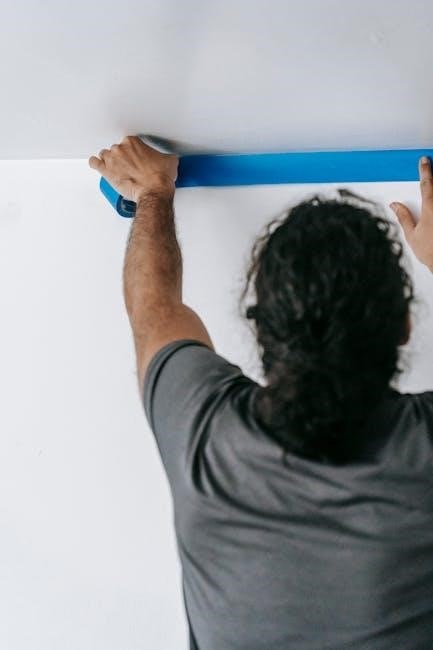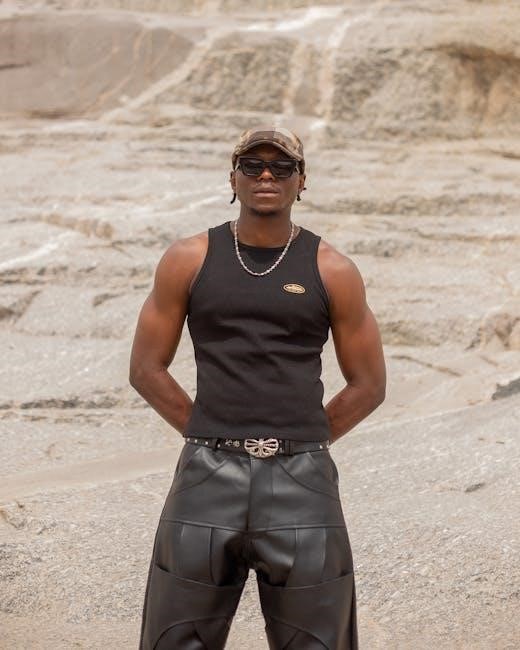A well-fitted belt is essential for both style and functionality. This guide helps you understand men’s belt sizes, how to measure your waist, and choose the perfect belt. Discover the difference between belt and pants sizes, and learn how to maintain your belt for longevity.
Understanding Men’s Belt Sizes
Men’s belt sizes are typically determined by adding 2-4 inches to your pants size, ensuring a comfortable and secure fit. This standard helps in selecting the right belt length, avoiding overly tight or loose adjustments.
How Belt Sizes Are Determined
Belt sizes are generally determined by adding 2 to 4 inches to your pants size, ensuring a comfortable fit. For example, if your pants size is 32 inches, your belt size would typically be 34 inches. This method accounts for the belt’s thickness and the space it occupies around your waist. Additionally, some manufacturers use a standard sizing chart where belt lengths are categorized into small, medium, large, and extra-large, corresponding to specific waist measurements. These sizes are often based on average body types and may vary slightly between brands. To ensure accuracy, it’s recommended to measure your natural waistline with a tape measure and refer to the specific brand’s sizing chart. This approach helps in selecting a belt that fits perfectly, neither too tight nor too loose, providing both comfort and functionality.

Difference Between Belt Size and Pants Size
Belt size and pants size are not identical, as belts are designed to fit around the natural waistline, while pants sizes are based on hip and waist measurements. Typically, belt sizes are 2 to 4 inches larger than pants sizes to accommodate the belt’s thickness and ensure a comfortable fit. For example, if your pants size is 32 inches, your belt size is usually 34 inches. This difference allows the belt to wrap around your waist without feeling too tight or restrictive. However, this can vary slightly between brands, as some may use a standard sizing chart while others base their sizes on direct waist measurements. To avoid confusion, it’s best to measure your waist directly or refer to the specific brand’s sizing guide. Understanding this difference ensures you choose a belt that complements your outfit and provides the right level of support and comfort.
Measuring Your Waist for the Perfect Fit
Accurate waist measurement is crucial for the right belt size. Use a tape measure around your natural waistline, where your pants typically sit. This ensures a comfortable and secure fit, guiding you to the ideal belt size.

How to Measure Your Waist
To ensure the perfect fit, measure your waist accurately. Use a flexible tape measure and wrap it around your natural waistline, typically where your pants sit. Keep the tape snug but not tight, ensuring it’s parallel to the floor. Take note of the measurement in inches or centimeters. For the most accurate result, measure without clothing or with a thin layer of fabric. If you’re unsure, consider measuring in the morning, as your waist size may fluctuate slightly throughout the day. This measurement will serve as the foundation for selecting the ideal belt size, ensuring comfort and functionality. Remember, proper fit is key to both style and practicality.
Where to Measure for Belt Size
To determine your belt size accurately, measure around your natural waistline, typically where your pants or trousers sit. This is usually just above the hipbone and around the narrowest part of your torso. Use a flexible tape measure and ensure it’s snug but not overly tight. The measurement should be taken at a consistent point to avoid discrepancies. If you wear your pants slightly lower or higher, adjust the measurement location accordingly to reflect where the belt will sit. For the most precise fit, measure without clothing or with a thin layer of fabric, as bulky clothing can distort the measurement. Marking this spot can help you visualize where the belt will rest, ensuring a comfortable and proper fit. Remember, the goal is to measure the circumference of your waist at the intended belt line for an accurate size. This step is crucial for selecting the right belt size and ensuring it complements your wardrobe effectively.

Choosing the Right Belt Size

Selecting the right belt size ensures comfort and style. Consider your waist measurement, pants size, and belt type. Standard belts offer fixed sizes, while one-size belts are adjustable. Proper fit is key for functionality and aesthetics.
Using Pants Size to Determine Belt Size
Using your pants size is a practical way to determine your belt size. Generally, your belt size is 2-4 inches larger than your pants size. For example, if you wear a 32-inch waist, your belt size would typically be 34 inches. This rule applies because belts need to accommodate the waistband and provide a comfortable fit. However, this can vary slightly depending on the brand or style of the belt. Some belts, especially one-size options, are adjustable and can fit a range of sizes. To ensure accuracy, it’s best to measure your waist directly, as pants sizes can sometimes be inconsistent. Proper fit is crucial for both functionality and aesthetics, so taking the time to measure or refer to a size chart can make a significant difference. Remember, the belt should sit comfortably in the middle notches, not too tight or too loose. This approach ensures you find the perfect belt to complement your wardrobe.
Standard vs. One-Size Belts
When choosing a belt, it’s important to consider whether a standard or one-size belt is right for you. Standard belts come in specific sizes, such as 30, 32, or 34 inches, and are designed to fit a particular waist measurement. These belts are ideal for those who know their exact size and prefer a precise fit. On the other hand, one-size belts are adjustable and can accommodate a range of waist sizes, typically measuring around 120 cm in length. These belts are versatile and suitable for individuals whose waist size may fluctuate or who prefer a more flexible option.
One-size belts often feature adjustable buckles or straps that allow you to cut the belt to your desired length, ensuring a perfect fit. Standard belts, while less flexible, offer a classic look and feel. Both options are popular, but the choice ultimately depends on personal preference and specific needs. Understanding the differences can help you make the best decision for your wardrobe.
Importance of Proper Fit
A properly fitted belt is essential for both comfort and style. It ensures your pants stay securely in place while complementing your outfit. A belt that is too tight can cause discomfort and restrict movement, while one that is too loose may not serve its purpose effectively. Finding the right balance is key to enjoying the functionality and aesthetic appeal of a belt.
The proper fit also enhances confidence, as it contributes to a polished and put-together look. A well-fitted belt distributes pressure evenly, preventing strain on the waistband of your pants. Additionally, it ensures the buckle sits centered, creating a balanced appearance. To achieve the perfect fit, consider the middle notches of the belt as your ideal position. This allows for slight adjustments without compromising comfort or style. Investing in a belt that fits correctly is a small but significant detail that elevates your entire wardrobe. By prioritizing proper fit, you ensure both practicality and sophistication in your daily attire.
Men’s Belt Size Chart
A men’s belt size chart provides a standardized guide to help determine the correct belt size based on waist measurements. It typically includes sizes ranging from 28 to 44 inches, catering to various fits and materials. Referencing the chart ensures a precise match, whether for standard or adjustable belts, and helps in selecting the ideal size for comfort and style.
Standard Belt Size Chart
A standard belt size chart is a straightforward guide that helps men determine their ideal belt size based on waist measurements. Typically, belt sizes range from 28 inches to 44 inches, with each size representing the total length of the belt. The chart is designed to align with common waist sizes, ensuring a comfortable and secure fit. For example, a 32-inch waist usually corresponds to a 34-inch belt size, as belts are generally 2-4 inches longer than pants sizes to accommodate the buckle and proper notching.
- Small sizes: 28-30 inches
- Medium sizes: 32-34 inches
- Large sizes: 36-38 inches
- Extra-large sizes: 40-44 inches

Using a tape measure, wrap it around your natural waistline to find your size. The belt should fit snugly, allowing enough room to fasten in the middle notch. This chart is a reliable tool for selecting the perfect belt, ensuring both style and functionality. Always refer to the chart for accurate sizing, especially when shopping online or trying a new brand.
One-Size Belt Size Chart
A one-size belt is designed to fit a wide range of waist sizes, offering versatility and convenience. These belts typically measure 120 cm in length and are fully adjustable, allowing them to accommodate waists from 28 inches to 40 inches or more. Unlike standard belts, one-size options eliminate the need to choose a specific size, making them ideal for individuals whose waist size may fluctuate or for those who prefer a universal fit.
- Length: Approximately 120 cm (47.24 inches)
- Adjustable to fit waists from 28 inches to 40 inches
- Materials: Often made from leather, fabric, or synthetic materials
- Features: Prong or buckle adjustments for precise fitting
One-size belts are perfect for casual or formal wear, as they can be tailored to your specific needs. They are also a great option for gifts, as they suit a broad range of sizes. When using a one-size belt, ensure it is not overly tight or loose, as this can affect comfort and durability. Measure your waist to determine the ideal adjustment point, and enjoy the flexibility of a single belt for multiple occasions.

Materials and Styles
Men’s belts come in various materials like leather, fabric, and synthetic options, offering durability and style. Styles range from casual to formal, ensuring a perfect match for any occasion, whether it’s a sporty look or a sophisticated event.
Leather Belts
Leather belts are a timeless choice for men, offering durability and a classic aesthetic. Made from high-quality materials, they are ideal for both formal and casual wear. Leather belts are known for their ability to develop a beautiful patina over time, adding character to the accessory. They are available in various finishes, such as polished, matte, or embossed, catering to different personal styles. One of the key advantages of leather belts is their longevity; with proper care, they can last for years. When shopping for a leather belt, consider the thickness and type of leather, as these factors impact both comfort and appearance. Full-grain leather is often preferred for its strength and natural look, while top-grain leather offers a smoother finish. Leather belts are versatile and can be paired with jeans, trousers, or chinos, making them a staple in every man’s wardrobe. Whether you’re dressing up for a formal event or keeping it casual, a leather belt is a reliable and stylish option.
Fabric and Synthetic Belts
Fabric and synthetic belts offer a modern and versatile alternative to traditional leather options. These belts are made from materials like canvas, nylon, or polyester, providing a lightweight and breathable option for everyday wear. Synthetic belts, often crafted from durable plastics or polyurethane, are known for their flexibility and resistance to wear and tear. Both fabric and synthetic belts are ideal for casual outfits, sports events, or summer attire, as they are often more comfortable in warmer climates. They come in a wide range of colors and patterns, allowing for a personalized touch to your wardrobe. Fabric belts are particularly popular for their soft texture and ease of use, while synthetic belts are praised for their sleek designs and low maintenance. Whether you’re looking for a sporty vibe or a relaxed, casual style, fabric and synthetic belts are a practical and fashionable choice. They are also easy to clean and maintain, making them a great option for active lifestyles. These belts are perfect for those who want a break from traditional leather while still enjoying a high-quality accessory.
Belt Styles for Different Occasions
Belt styles vary to suit different occasions, ensuring your accessory complements your outfit perfectly. For formal events, a sleek leather belt in classic colors like black or brown is ideal, pairing seamlessly with suits or dress pants. Business casual settings call for slightly more versatile options, such as a leather belt with subtle detailing or a high-quality fabric belt in neutral tones. Casual outings, like sporting events or weekend gatherings, are perfect for bold or textured belts, such as canvas, nylon, or even embroidered designs. Adjustable belts are also a great choice for versatility, allowing you to customize the fit and style to your outfit. Reversible belts offer another practical option, providing two looks in one accessory. Whether you’re dressing up or keeping it relaxed, the right belt style can elevate your look and ensure a polished finish. By choosing a belt that matches the occasion, you can create a cohesive and stylish ensemble that reflects your personal taste.
Adjustable Belts
Adjustable belts are a versatile and practical choice for men, offering a one-size-fits-most solution. These belts are designed with an adjustable buckle that allows you to customize the fit to your waist size without the need for predefined holes. They are particularly useful for individuals whose waist size may fluctuate or for those who prefer a belt that can be worn with multiple outfits. Adjustable belts often feature a simple, sleek design and are available in various materials, including leather, fabric, and synthetic options. One of the key advantages of adjustable belts is their universality, as they can accommodate a wide range of waist sizes, typically from 28 inches to 40 inches or more. This makes them an excellent option for gifts or for men who want a belt that will remain functional over time. Additionally, adjustable belts are easy to use, with a sliding mechanism or buckle that secures the desired length. They are suitable for both casual and formal occasions, providing a reliable and comfortable fit. Adjustable belts are a practical choice for everyday wear, offering both convenience and style.

Tips for Buying a Belt Online
Buying a belt online can be convenient, but it requires careful consideration to ensure the right fit and style. Always start by measuring your waist accurately using a tape measure, as this will help you determine the correct size. Check the seller’s size chart, as sizes can vary between brands. Consider the material and style to match your wardrobe needs—leather belts are classic, while fabric or synthetic belts offer versatility. Read customer reviews to gain insights into the belt’s quality and fit. If unsure, opt for an adjustable belt, which provides flexibility. Pay attention to the buckle type and ensure it suits your lifestyle, whether for formal or casual wear. Finally, check the return policy in case the belt does not fit perfectly. By following these tips, you can confidently select the right belt online that complements your style and provides a comfortable fit.

Common Mistakes When Choosing a Belt Size
When selecting a belt, many men make avoidable mistakes that can lead to an ill-fitting accessory. One of the most common errors is assuming that belt size directly matches pants size, but this is not always accurate. Pants sizes often include additional fabric for comfort, so belts are typically 2-4 inches larger. Another mistake is not measuring the natural waistline, where the belt will actually sit, rather than relying on pant size alone. Some men also overlook the difference between standard and one-size belts, which can result in a poor fit. Additionally, failing to consider the buckle size and style can affect both functionality and aesthetics. Ignoring the material’s stretch or flexibility is another oversight, as it can impact long-term comfort. Lastly, not checking the belt’s length relative to the waist measurement can lead to a belt that is either too short or too long. Avoiding these mistakes ensures a belt that enhances both style and comfort.
Belt Care and Maintenance
Proper care and maintenance are essential to extend the life of your belt and keep it looking its best. For leather belts, avoid exposure to direct sunlight or moisture, as this can cause cracking or discoloration. Use a leather conditioner periodically to maintain suppleness and protect the material. Fabric or synthetic belts can be spot-cleaned with a damp cloth, but avoid harsh chemicals that may damage the material. For metal buckles, gently polish with a soft cloth to remove tarnish or scratches. Store belts in a cool, dry place, away from direct sunlight, to prevent warping or fading. Avoid over-stretching adjustable belts, as this can weaken the material. Regularly inspect your belt for signs of wear, such as frayed edges or loose stitching, and address these issues promptly. By following these simple care tips, you can ensure your belt remains a durable and stylish accessory for years to come.

Frequently Asked Questions
How do I determine my belt size? Your belt size is typically 2-4 inches larger than your pants size, depending on the brand and style. Measure your natural waistline or refer to your pants size for guidance.
Can I use my pants size to buy a belt? Yes, but add 2-4 inches to your pants size to get your belt size. For example, if you wear a 32-inch pant, your belt size would be 34-36 inches.
What is the difference between standard and one-size belts? Standard belts come in fixed sizes, while one-size belts are adjustable and can fit a range of waist sizes, usually up to 40 inches.
How do I care for my leather belt? Avoid direct sunlight and moisture, and use a leather conditioner to maintain its quality. For fabric belts, spot-clean with a damp cloth and avoid harsh chemicals.
Why is proper belt fit important? A well-fitted belt ensures comfort, prevents pants from sagging, and complements your outfit. It should sit comfortably in the middle notches, not too tight or too loose.
Can I return or exchange a belt if it doesn’t fit? Most retailers offer returns or exchanges, but check their policies before purchasing, especially when buying online.
Selecting the right belt size is crucial for both comfort and style. By understanding how belt sizes are determined and learning to measure your waist accurately, you can ensure a perfect fit. Remember, your belt size is typically 2-4 inches larger than your pants size, and proper fit means the belt should sit comfortably in the middle notches. Whether you prefer standard sizes or adjustable belts, there’s an option to suit your needs. Leather belts offer durability and classic style, while fabric and synthetic options provide versatility. Always consider the occasion and your outfit when choosing a belt. For online shopping, refer to size charts and customer reviews to avoid common mistakes. Regular care, like conditioning leather and avoiding harsh chemicals, will extend the life of your belt. With this guide, you’re equipped to make informed decisions and find the ideal belt to elevate your wardrobe. Happy shopping!

